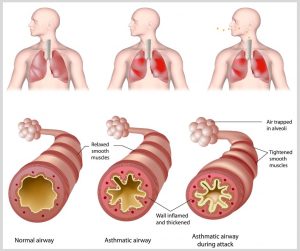ASTHMA: THE OVERVIEW.
- Asthma is a disease of the airways to the lungs. It may make some physical activities difficult or perhaps impossible.
- According to the Centers for sickness management and hindrance (CDC), some twenty-five million Americans Trusted Source have a respiratory illness.
- It’s the foremost common chronic condition among American children: child out of each Trusted Source has a respiratory illness.
- To understand the respiratory illness, it’s necessary to grasp a touch regarding what happens when you breathe.
- Normally, with each breath you’re taking, air goes through your nose or mouth and down into your throat and into your airways, eventually creating it to your lungs.
- There area unit many little air passages in your lungs that facilitate deliver oxygen from the air into your blood.
- Asthma symptoms occur once the liner of your airways swell and also the muscles around them tighten.
- Secretion then fills the airways, more reducing the number of air which will taste.
- These conditions will then create a respiratory illness “attack,” the coughing and tightness in your chest that’s typical of respiratory illness.

THE CAUSES
The strongest risk factors for developing respiratory illness area unit a mixture of genetic predisposition with environmental exposure to indrawn substances and particles which will provoke hypersensitivity or irritate the airways, such as:
- indoor allergens (for example, house dirt mites in bedding, carpets and stuffed furnishings, pollution and pet dander)
- outdoor allergens (such as pollens and moulds).
- tobacco smoke.
- chemical irritants within the work.
- air pollution.
- Other triggers will embody cold air, extreme arousal like anger or concern, and physical exertion.
- Even bound medications will trigger asthma: analgesic and alternative non-steroid medication, and beta-blockers (which area unit used to treat high-pressure level, heart conditions and migraine).
- Urbanization has been related to a rise in respiratory illness prevalence. however, the precise nature of this relationship is unclear.

SYMPTOMS.
- The classic signs and symptoms of asthma are shortness of breath, cough (often worse at night).
- Asthmatic (high-pitched whistling sound created by turbulent airflow through slim airways, generally with exhalation).
- several patients additionally report chest tightness.
- it’s necessary to notice that these symptoms area unit episodic, and people with respiratory illness will go long periods with none symptoms.
- Common triggers for wheezy symptoms embrace exposure to allergens (pets, dust mites, cockroach, moulds, and pollens), exercise, and microorganism infections.
- alternative triggers embrace the sturdy feeling, odour exposure, and temperature extremes.
- Tobacco use or exposure to second-hand smoke complicates respiratory illness management.
TREATMENT
There area unit 2 main varieties of medications wont to treat asthma:
- Long-term management medications such as indrawn corticosteroids area unit the foremost necessary medications wont to keep the respiratory illness in restraint.
- These preventive medications treat the airway inflammation that ends up in respiratory illness symptoms.
- Used on a daily, these medications will cut back or eliminate respiratory illness flare-ups.
- Quick-relief inhalers contain a fast-acting medication like Proventil.
- These medications area unit is typically known as rescue inhalers.
- they are used PRN to quickly open your airways and build respiratory easier. Knowing once to use these medications will facilitate forestall an at hand asthma.
- Long-term management medications area unit the key to keeping your respiratory illness controlled and within the inexperienced zone.
- If you regularly use a quick-relief inhalator to treat symptoms, your respiratory illness is not in restraint. See your doctor regarding creating treatment changes.
